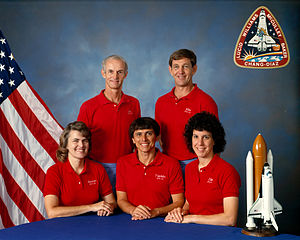
Back STS-34 Arabic STS-34 Bulgarian STS-34 Czech STS-34 Danish STS-34 German STS-34 Estonian استیاس-۳۴ Persian STS-34 French STS-34 Galician STS-34 HE
 Galileo and its Inertial Upper Stage (IUS) in the payload bay of Atlantis | |
| Names | Space Transportation System-34 STS-34 |
|---|---|
| Mission type | Galileo spacecraft deployment |
| Operator | NASA |
| COSPAR ID | 1989-084A |
| SATCAT no. | 20297 |
| Mission duration | 4 days, 23 hours, 39 minutes, 21 seconds (achieved) |
| Distance travelled | 2,900,000 km (1,800,000 mi) |
| Orbits completed | 79 |
| Spacecraft properties | |
| Spacecraft | Space Shuttle Atlantis |
| Launch mass | 116,831 kg (257,568 lb) |
| Landing mass | 88,881 kg (195,949 lb) |
| Payload mass | 22,064 kg (48,643 lb) |
| Crew | |
| Crew size | 5 |
| Members | |
| Start of mission | |
| Launch date | October 18, 1989, 16:53:40 UTC |
| Rocket | Space Shuttle Atlantis |
| Launch site | Kennedy Space Center, LC-39B |
| Contractor | Rockwell International |
| End of mission | |
| Landing date | October 23, 1989, 16:33:01 UTC |
| Landing site | Edwards Air Force Base, Runway 23 |
| Orbital parameters | |
| Reference system | Geocentric orbit |
| Regime | Low Earth orbit |
| Perigee altitude | 298 km (185 mi) |
| Apogee altitude | 307 km (191 mi) |
| Inclination | 34.33° |
| Period | 90.60 minutes |
| Instruments | |
| |
 STS-34 mission patch  Back row: Donald E. Williams and Michael J. McCulley Front row: Shannon W. Lucid, Franklin R. Chang-Díaz, Ellen S. Baker | |
STS-34 was a NASA Space Shuttle mission using Atlantis. It was the 31st shuttle mission overall, and the fifth flight for Atlantis.[1] STS-34 launched from Kennedy Space Center, Florida, on October 18, 1989, and landed at Edwards Air Force Base, California, on October 23, 1989. During the mission, the Jupiter-bound Galileo probe was deployed into space.
- ^ "STS-34 Press Kit" (PDF). NASA. October 1989. Archived (PDF) from the original on January 6, 2021. Retrieved January 6, 2021.
 This article incorporates text from this source, which is in the public domain.
This article incorporates text from this source, which is in the public domain.